Pros
Cons
Introduction
Product Tour
Front
On the front of the DSC-TX7 is a large panel which slides down (shown below). When this is in the up position, it turns the camera off and protects the lens and other features.
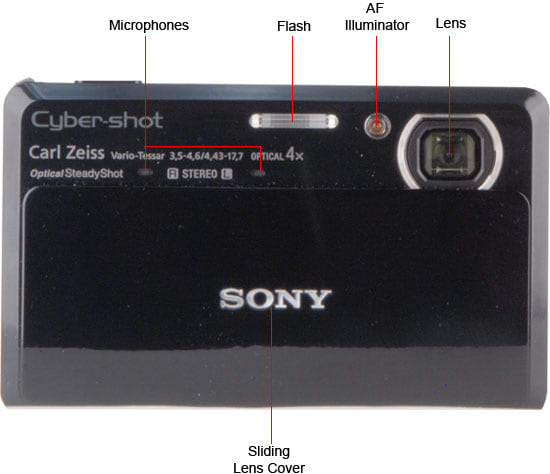
Back

Sides

Top
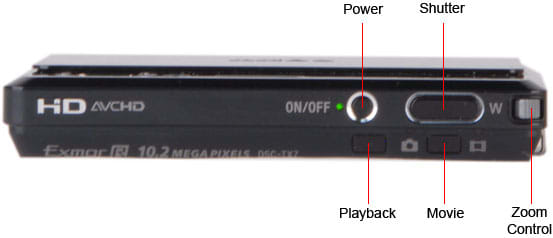
**Size Comparisons **
**In the Box **
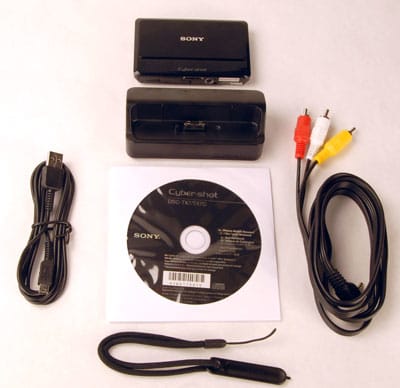
The contents of the box of the DSC-TX7
• The DSC-TX7 camera
• The camera stand
• Wrist strap
• 'Paint pen' for operating touch screen
• USB cable
• A/V output cable
Not included is a memory card or a HDMI cable: you'll need to supply your own.
Color
**Color Accuracy ***(14.39) *
This test looks at how accurately a camera captures colors: how closely do the photos mirror the colors in the real world? The answer for the Cyber-shot DSC-TX7 is pretty darn close. We found that the TX7 captured very accurate color in our tests, which involve photographing a color char that contains 24 common colors. The only colors that it struggled with were the purples and reds, which were slightly muted. The TX7 also didn't punch the colors up for effect by oversaturating them, like some cameras do. Click here for more on how we test color
NOTE: Because of the way computer monitors reproduce colors, the images above do not exactly match the originals found on the chart or in the captured images. The chart should be used to judge the relative color shift, not the absolute captured colors.
Color Modes*(0.00)*
The TX7 is somewhat unusual in that it does not offer color modes: there is no way to tweak the colors in the image as it is captured. You can do some processing on captured images, though; we cover these in the Playback section of the review.
Noise
Noise*(13.47)*
Noise is the curse of digital photographs. All digital cameras have noise, where the circuits inside the camera capture their own internal noise as well as the image. As the sensitivity of the camera increases with an increasing ISO, this becomes more pronounced. This didn't seem to be a huge issue on the TX7, though; we found low noise in images all the way up to an ISO setting of 800. Above, this the noise got more pronounced, but it remained lower than other cameras we have tested. However, this low noise has a price: images at ISO levels above 125 have a slight loss of detail caused by the noise reduction that the camera applies: you can see examples of this in the crops below. Click here for more on how we test noise.
In the chart above, we look at the noise in images taken at different ISO settings under two lighting conditions: 3000 lux (equivalent to a cloudy day) and 60 lux (equivalent to indoor lighting). We saw the same behavior in both situations, with the noise remaining flat between ISO 125 and 800. Above this it climbed significantly, with more noise in the low light test.
The chart above compares the TX7 with other cameras, and you can see that it does well; the noise is consistently lower than our comparison models at the lower ISO settings, and is still competitive above ISO 800.
ISO*(5.50)*
The TX7 has a wide ISO range: from 125 to 3200, all at the full 10 megapixel resolution of the camera. There are a few limitations to remember, though: all of the burst modes limits that range to 125 to 800. And, as the results above and the samples below show, the noise reduction that the camera uses to keep the noise down results in a significant loss of detail, especially at ISO levels above 800.
NOTE: The images above are not used in our testing or scoring, but are included here to show real-world examples of the differences between cameras at the various ISO settings.
Resolution
Resolution*(11.39)*
We were also favorably impressed with the performance of the TX7 in our tests on the resolution of the images it captures. We found that the images were sharp and had only slight distortion across the 4x zoom range that this camera can manage. The only issue that we saw was a small amount of chromatic aberration in the middle of the zoom range Click here for more on how we test resolution.
Distortion (10.28)
We found that the images that this camera captured had very low distortion at the mid and telephoto points of the zoom range, with both showing less than 0.5 per cent distortion, which is pretty much invisible. There was a bit more at the widest point of the zoom range, though; we saw about 1.5 per cent distortion, which is just enough to be visible: long thin objects like lamp posts and walls will look slightly distorted. Below are examples of the distortion from our test chart.
Sharpness (14.07)
We found that the images captured by the TX7 were pretty sharp for the most part, although the sharpness did fall off somewhat at the edge of the frame in all of our test images, as you can see in the examples below. This slight drop in sharpness was present at all points on the zoom range, but was particularly pronounced at the wide and telephoto ends of the zoom range, where it became quite significant.
Chromatic Aberration (6.37)
The other thing that we noticed was that there was a significant amount of chromatic aberration (CA) at the widest end of the zoom range on the edges of the frame. The amount of CA that we saw at the mid and telephoto zoom points was low, but there was a lot at the widest zoom point, which shows in the wide crops on the charts below and our sample photos as a distinct color fringe to sharp edges.
Picture Quality & Size Options*(6.00)*
The TX7 offers only a limited amount of control over the size and quality of the images that it takes: you can't control the quality of the compression, and there are just 5 options for the image size. When the camera is in easy mode, the choices are even fewer: you get options for large (10 megapixel) or small (5 megapixel) images.
Image Stabilization*(8.12)*
The TX7 pulls all the stops out when it comes to image stabilization: as well as an optical image stabilization system (which moves an element of the lens to compensate for movement) there is a special mode called Anti-Motion Blur. What this does is to take 6 images in quick succession, then combines them to create a single, sharper image. In the same situation, other cameras would have to take a longer exposure, with more possible issues of blurring. The Ant-Motion Blur seems to work very well: when we compared images taken in the program mode of the camera against those taken in the Anti-Motion blur mode, the latter were significantly sharper and had less blurring. There is a minor downside, though; the images don't appear on the screen for several seconds (as the camera has to process them), and you can't take images quickly. This might be an issue if you are trying to capture a soccer game or other fast-moving sport. Click here for more on how we test image stabilization.
Video
Movie Mode*(16.25)*
The TX7 is one of the new breed of compact cameras that captures high definition video. It can capture video with a maximum resolution of 1920 by 1080 pixels at 60 interlaced frames a second and a bit rate of either 17 or 9 Mbps, which is the same as last years camcorders (many of this years models have increased the bit rate to 24 Mbps, which produces better quality). The video files can be saved in either AVCHD or MPEG4 format (although the MPEG4 format limits the resolution to 1440 by 1080), both formats that are compatible with many video editing applications. Both will require conversion to upload to a video sharing service such as YouTube, though.
The 4x optical zoom can also be used while recording, but we did notice that the auto focus has a slight tendency to swim as you zoom, with the image getting slightly blurry while the camera is refocusing. We didn't hear any noise from this zoom mechanism in the recording, though. The TX7 is also unusual in capturing stereo sound; most cameras just capture mono sound.
Video Color*(5.49)*
Although the TX7 captured good color in still images, the colors in videos were less appealing: our test chart showed overly saturated colors that looked a little garish. They were not as bad as many of the cameras that we test, but it was disappointing to see that the accurate color of stills wasn't carried over to video. There is also no way to tweak this color within the camera: the only controls that you get are for the video quality, white balance and a self timer. Click here for more on how we test video color.
Video Sharpness*(2.32)*
We did find that the videos were pretty sharp, though; capturing video on the highest quality setting (AVCHD at 17Mbps) we saw a good amount of detail in the video and it looked smooth. Click here for more on how we test video sharpness.
Sample Photos
Sample Photos
In the following sample images, clicking on the larger image will download the full resolution original. Each photo is accompanied by three actual-size crops.
Still Life Examples
Below are sample photos of our still life, taken at the indicated ISO level in program mode with the flash turned off. To see the full image, click on any of the thumbnails, but remember that these images are several megabytes in size and may take some time to download.
NOTE: The images above are not used in our testing or scoring, but are included here to show real-world examples of the differences between cameras at the various ISO settings.
Playback
Playback Mode*(9.00)*
The TX7 has a big, bright sharp screen, and the playback options that it offers make the most of this, offering a variety of slideshow options, so you can show off your shots. Slide shows can be easily created with a number of transition effects, and it comes with four types of music, as well as the ability to upload your own MP3s with the bundled 'Music Transfer' application. Images can also be viewed in a number of different ways, including a calendar view, up to 28 thumbnails on screen at once. The event view that is present on other Sony cameras is not available on this one, though.
In-Camera Editing*(6.25)*
The TX7 provides you with a reasonable selection of editing tools: you can crop, resize and rotate images with ease. A tool for removing red eye is also available, as well as a rather basic image editing program. We question the usefulness of this: it allows you to draw directly on the image itself, but the touch screen isn't of a high enough resolution to be actually useful. The only possibly useful feature is a tool to add a range of stamps (such as hearts, sparkles and the like) to images and to add frames to images. Actually, calling this useful is perhaps overstating the case: it might appeal to the bedazzler fan, but everyone else is likely to run away screaming.

One of the editing menus
Direct Print Options*(6.25)*
The usual direct printing features are included: the camera supports DPOF and PictBridge. DPOF allows you to flag images on the memory card for printing, and when you insert this memory card into a printer, the printer will detect the flagged images and print them. PictBridge support means that this camera can be connected directly to a printer that supports it to print without a computer.
This is also one of the first cameras to support TransferJet, a new wireless connection system that can be used to quickly transfer images between cameras. We were not able to test this feature as we don't have another TransferJet device available, but Sony and several other manufacturers are releasing devices that support this new standard.
Hardware
Viewfinder*(0.00)*
There is no viewfinder on this camera: photos are framed on the LCD screen on the back of the camera body.
LCD*(9.33)*
The LCD screen on the back of the TX7 is a very impressive 3.5-inch model with a 921,000 pixel resolution. The high resolution of this screen shows: images on it look very clear and sharp, and movement on the screen is pretty smooth. It isn't as smooth as a decent HDTV, but it is smooth enough to allow you to see details on moving objects.

The LCD screen of the TX7
The screen takes up the entire back of the camera: there are no additional controls or buttons. All of the features of the camera are controlled through this touch screen: you tap it to tell the camera where to focus or to access the on-screen menu. We found this touch screen to be pretty responsive; it did miss occasional taps, but responded quickly when it detected the tap. Sony includes a small piece of plastic it refers to as the paint pen for using on this screen, but we didn't find that this made much difference.
Flash*(5.25)*
The flash of the TX7 is very small, and is located to the left of the lens. We found it was fairly powerful, though, allowing us to take photos in total darkness out to a range of about 10 to 11 feet. Between the lens and the flash is the AF assist light.
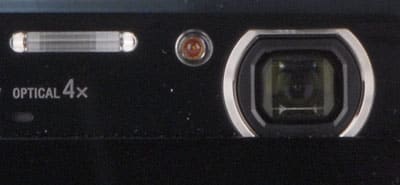
The flash and lens of the TX7
The flash has a standard selection of modes, including a full auto, off, forced on and a slow sync, which combines the flash with a slow shutter speed.
Lens*(3.50)*
The 4x lens of the TX7 is completely enclosed in the camera body: it does not poke out of the camera body at all in use. It has a focal length range of 4.43mm to 17.7 mm, which is equivalent to a 25 to 100mm lens on a 35mm film camera. That's a decent range for a compact camera, with a good wide angle setting for shooting groups or landscapes.
The aperture range of the lens is a fairly decent for a compact point & shoot camera, though; it goes from f/3.5 to f/6.3, which is a little wider than most.
Battery*(5.00)*
The DSC-TX7 is powered by a small NP-BN1 Lithium Ion battery that holds just 630 mAh of charge. That is not a lot, especially with the big screen, so it is not surprising that Sony quotes a battery life of 115 shots. We wouldn't disagree with this: in our informal tests, we found that the camera seldom lasted more than a day or two of moderate use. A spare battery will cost you $50.

The battery and memory card compartment of the TX7
The battery fits into the camera in a cavity at the bottom, which is covered by a small latched door. The memory card fits into the same location. The battery is charged in an external charger, although there is an optional power supply which charges the camera in the dock.
Memory*(5.50)*
Sony has vowed that all of their 2010 camera models will be able to use both their own MemoryStick and SDHC memory cards, and the TX7 is one of the first to come with a memory card slot that can handle both. This means you can use either SDHC or MemoryStick Pro Duo memory cards, which is a plus if you are upgrading from an older camera that uses SD Cards. A new 4GB MemoryStick Pro Duo card will cost you about $20.
Jacks, Ports & Plugs*(3.50)*
There is just a single connector on the camera body: a proprietary port that connects to the included dock. The camera fits neatly into this dock, and this includes ports for USB, HDMI and power connections. While this does provide a neat way to connect the computer to a desktop PC or TV without having cables running everywhere, it is a pain if you want to copy photos off the memory card while you are on the road: you'll have to take the dock along with you.

*The TX7 in the included dock
*

The ports on the back of the TX7 dock: power, USB, HDMI and A/V out
*
*
Controls
Shooting Modes*(14.75)*
If you want the camera to do the hard work of choosing settings to use, the TX7 has you covered: you can put the camera into program mode, Intelligent Auto Adjustment mode or the Easy mode. As the names suggest, these offer varying amounts of user control; the program mode lets you configure most settings, while the Intelligent Auto Adjustment mode cuts down on the number of options that the user is presented with. The Easy mode puts everything into automatic; the only thing the user has control over is the image size, if the flash is in auto mode or is off and the self timer. This is obviously designed for the novice or nervous shooter, and it works well for that. It also increases the font size of the menu options for those who may have difficulty reading the small text of the other modes.
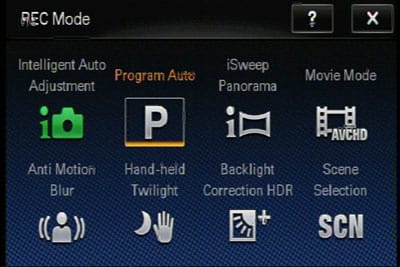
*The Rec modes menu of the TX7 *

*The Scene Modes menu of the TX7 *
A wide selection of scene modes are also on offer: 12 in total. These include options such as Twilight, Gourmet, Pet and hi-speed shutter. In addition to these, the TX7 offers 4 special shooting modes:
iSweep Panorama *- This mode allows you to take panoramic shots with a single sweep of the camera: you press the shutter, sweep the camera around in the indicated direction, and it takes a series of photos and stitches them together to form the panorama. These can be either vertical or horizontal panoramas, and we were impressed with the quality of the results: the camera did a good job of producing smooth, clean panoramas with little evidence of clipping or where the frames are blended together. This mode pioneered with the DSC-HX1 that was launched last year, but Sony claims to have improved it since then. It still needs to be used carefully, though, as it still has a habit of chopping moving objects up as it creates the panorama: look at the car in the second example below, which is chopped up on the right and appears twice in the same image.
*
Anti Motion Blur - In this mode, the camera takes 6 shots in quick succession, then amalgamates the shots to produce the sharpest image. The results are processed to make the image as sharp as possible. We found this to be very effective; in the photos below, the one on the left was taken in program mode, and the right one in Anti-Motion Blur mode. The right one is much sharper because the camera was able to compensate for the camera shake in this photo that was taken in the early evening.
*
*
Hand-Held Twilight - Shooting in the evening hour can be tricky: low light means that you have to use a longer shutter speed, which means a blurry image. This mode tries to get around this by quickly taking 6 photos, then combining the images to form the final one, discarding any images that are blurry. We found that this produced very attractive results, producing sharper images with more dynamic range than images taken in the standard night scene mode (see example below).
**
Backlight Correction HDR - This mode combines two images taken at different exposure settings to deal with overexposure caused by photographing a subject against a bright background, such as a bright blue sky. The camera takes one photo metering for the background and another metering for the subject, then combines the two to try and capture the detail of the subject. In the examples below, the left photo was taken in program mode, and the right in Backlight Correction HDR. *
*
- *
One thing that is missing from this camera is any sort of manual control: there is no way to set the shutter speed or aperture directly on this camera. *
*
Picture Effects*(0.00)*
The TX7 does not offer any picture effects that can be used while shooting, but we don't consider that to be a big loss.
Focus*(6.50)*
We found the auto focus of the TX7 to be generally pretty quick, both in normal light and low light. It usually took less than a second to find the right focus point, and was often much quicker. There are also a number of ways to control the focusing, including a neat feature where you tap on the screen to select the focus point. This is useful if you are trying to take a photo with the subject off-center. You can also set the camera to either automatically use 9 focus points, or to the center of the screen as the focus point, looking either at a small area or a single point in the middle.
Face detection is also available, with the camera being able to recognize up to 8 faces in the frame. You can either select the face to use as the focus point by tapping on it, or set the camera to prioritize on adult or child faces.
Exposure*(2.50)*
A limited amount of control over how the camera exposes is available: in program mode, you can apply up to 2 stops of exposure compensation, in one third of a stop steps. This control (which Sony calls EV) is a little buried, though; you have to go into the main menu and select it, then set the level of compensation with a draggable scale on the screen. This camera does not support auto exposure bracketing: there is no way to get it to take a series of exposures at different levels automatically.
Metering*(8.50)*
The usual metering mode options are available in program mode: there is an automatic evaluative mode (called multi), center weighted and spot metering. Enabling face detection also sets the camera to meter correctly for the faces in the image.
White Balance*(6.00)*
The common options are also available for white balance: you can set it to auto or any one of 7 presets (which include an option for flash). A custom mode is also available, where you take a photo of a white object and the camera uses this to judge the white balance point.
Aperture*(5.50)*
The TX7 has a decent aperture range for a compact point & shoot; it has a range of f/3.5 to f/6.3 at all zoom settings. That's a good range for a point & shoot
Shutter Speed*(5.00)*
The shutter speed range of the TX7 is also decent: it can go from a 1 second exposure down to 1/1600 of a second. Night owls might miss the longer shutter speeds that some cameras offer, but that's a wide enough range for a general use camera.
Self-Timer*(5.00)*
As well as the usual options of a 2 or 10 second delay, the TX7 also uses its face detection as a self timer. It can hold on taking the photo until it detects either one or two faces in the frame for self portrait or couple shots. There is also a smile detect feature that can be used to take a smiling self portrait by holding off from taking the photo until it detects a smile.
Drive/Burst Mode*(5.50)*
The fancy Exmor sensor chip inside this camera gives it an edge: Sony claims it can capture a burst of 10 images at full resolution in around a second. We found it was a little slower than that (see below), but it is still a pretty speedy camera. There are also three options for burst mode; high, medium and low. The low speed captures about 2 frames a second, but is still limited to 10 shots. Unfortunately, there is no mode for continuously shooting images and saving them to the memory card, or a mode for shooting images at a preset interval.
Shot to Shot (10.49)
The TX7 is a speedy camera: we measured the fastest burst rate at 8.88 frames per second, a whisker below the 10 fps figure that Sony quotes. Some other point & shoot cameras can achieve similar speeds by reducing the resolution, but the TX7 still captures the full resolution 10 megapixel images at this speed, which is impressive.
Design & Handling
Handling*(5.00)*
The TX7 is a mixed bag when it comes to handling the camera in use. There is nothing on the front of the camera for the fingertips to hold onto, and the smooth coating of the camera makes it slippery. While the large screen on the back is a good thing, it leaves only a small area for the thumb to land on when holding the camera in one hand. There is a small set of ridges, but the thumb slips off these quite a lot, which can lead to inadvertent touches of the screen.
Buttons & Dials*(5.50)*
There are just a handful of physical buttons on this camera: on the top are the power, shutter and zoom controls, plus buttons for playback mode and switching between still and movie modes. All of these buttons are rather small, and the zoom control is very poorly placed right on the corner of the camera body. This is uncomfortable to reach, and this contributes to the loose grip that you have on the camera. So, don't forget to use the wrist strap that comes with the TX7, because you'll need it.
All of the other controls on this camera are accessed through the touch screen interface, which is another mixed bag. We found that the screen sometimes missed touches, and took some time to respond at other times. The screen also ignores you if you touch the screen in more than one location, and that's easy to do if your thumb ends up resting on the top right of the screen by accident.Using the included paint pen (a small piece of plastic that fits onto the wrist strap) improves the situation slightly, but the touch screen is still somewhat awkward to use.
Menu*(5.50)*
Because the TX7 relies on the touch screen for all of its operations, the on-screen menu is very important. We found that, once again, that using this was a mixed experience. The touch screen works well enough when you are pressing buttons on the screen (such as pressing the button to start capturing a movie), but it is kind of awkward when you have to scroll around to access a menu option; the scroll buttons are small and easy to miss.

Caption
If a user is uncomfortable with the menu, it might be worth putting the camera into easy mode, which offers simpler menus with larger text and fewer options.
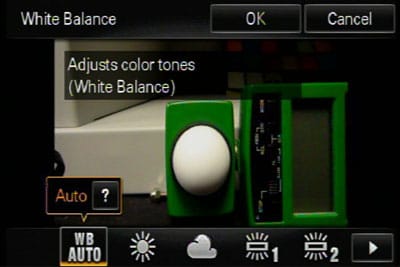
The White Balance menu of the TX7
Manual & Learning*(5.50)*
The TX7 comes with a handbook which covers the use of the camera in detail. This is generally well written and easy to use, but it does gloss over some of the details on how the features of this camera work. The Hand-held twilight mode, for instance, is described thus: 'Although night scenes tend to blur by camera shake, this mode allows you to shoot night scenes with less noise without using a tripod.' While that is true, it is not helpful in explaining what the mode does or how to get the best results out of it.
Sony T900 Comp
The Cyber-shot DSC-TX7 has a very similar look and style to its slightly older cousin, the DSC-T900. Both are small, sleek compact cameras that have a slide-up cover on the front that protects the lens and a big, 3.5-inch LCD screen on the back that has a very high 921k pixel resolution. But the TX7 is slightly smaller (at just 0.68 inches thick) and includes the Sony Exmor R sensor that brings a number of new features into play, such as the ability to capture 10 full resolution frames in a second and a one-touch panorama mode.
These improvements in the TX7 are underlined by our test scores, where the TX7 scored higher in noise and resolution, and much higher in image stabilization, thanks to its new Anti-Motion Blur mode. The T900 has none of these new modes, so we would only recommend it over the TX7 if you find a particularly good deal on this older model.
Samsung TL225 Comp
Both of these cameras are small and sleek enough to fit into a shirt pocket with space left over, but they are quite different in other ways. The lens of the TX7 is entirely within the body, while the TL225 lens telescopes out when the camera is in use. This does mean that the TL225 has a slightly longer zoom ratio, though; 4.6x against the 4x of the TX7.
We found that the two cameras were pretty evenly matched in many of our tests, with both scoring about the same on our tests for noise and resolution. The TX7 had slightly better color, though, and has the advantage of a much superior image stabilization mode.
The ace up the TL225's sleeve is the 1.5-inch front screen, which allows you to take self portraits or entrance small children, while the TX7 goes with several modes to enhance low-light shooting and a fancy panorama mode that makes shooting panoramas a breeze. The choice between the two cameras may come down to which features are the more useful, as both cameras take great photos.
Canon S90 Comp
Both of these cameras cost the same: about $400. But they differ greatly in other ways, with the Sony offering more in the way of fancy features, and the S90 offering much wider manual controls. The S90 looks rather chunky compared to the slimline TX7, but both cameras are small enough to fit into a pocket or small bag.
We found that both cameras performed well, with strong scores for resolution and noise, although the TX7 had a slight edge in color and performed significantly better in our image stabilization test, where the Anti-Motion Blur mode produced much sharper images.
Conclusion
Meet the tester
Richard Baguley is a veteran writer who has written about technology ranging from Alphabet to Zip file utilities. He has contributed to pretty much every major tech publication, including Amiga Format Magazine, PC World, Wired, CNET, Toms Guide, Forbes, and many others. He lives in the Boston metro area with his wife, dog, and an indeterminate number of cats.
Checking our work.
Our team is here to help you buy the best stuff and love what you own. Our writers, editors, and experts obsess over the products we cover to make sure you're confident and satisfied. Have a different opinion about something we recommend? Email us and we'll compare notes.
Shoot us an email